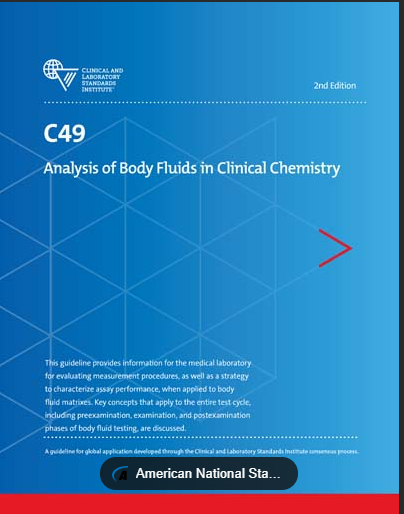A guide for Body Fluid validation is available from CLSI. C49 Analysis of Body Fluids in Clinical Chemistry should be reviewed, and you should review your laboratory's validations for possible weakness when a CAP inspector asks "Do you have any LDTs? or "Are you using any a applications off-label?", or just "Are you performing body fluid testing?"
Using a spreadsheet here are the suggested validations from the CLSI document and a place for what we have done and place for my medical director to detail if we need additional validation.
I provide this for you, but with the caveat that it does not replace the need for you to obtain the CLSI document and review it yourself. It will be well worth your effort.
|
Key Point |
Current Processes |
Follow Up Actions |
|
Definitions of Fluids: Includes names
of processes of removal (BF—centesis) Pericardial Peritoneal- aka Ascitic fluid Pleural |
|
|
|
Proper instruction provided for
collection and transport is provided to user; being part of validation for
body fluid testing. |
|
|
|
Laboratory needs to evaluate clinical
requests and inform which tests will not be provided. |
|
|
|
Pleural Fluid for pH should be
collected and tested as blood gas sample. |
|
|
|
Specimen processing: pretreatment,
specimen viscosity issues and various techniques: dilution, freeze-thaw
cycles, hyaluronidase. These processes
should be included in validation plan. |
|
|
|
Measurement Procedure Selection based on expected measuring range need to consider appropriate analyzer
application [and reagent choice]. |
|
|
|
Measurement Procedure Validation- Accuracy: comparative reference measurement, spiked studies, 40 samples. |
|
|
|
Measurement Procedure Validation- Spiked
Recovery: three specimens each spiked three times with comparison
of observed vs. expected results. |
|
|
|
Measurement Procedure Validation- Mixing
Studies: 3 pair specimen sets. |
|
|
|
Measurement Procedure Validation- Dilution
Recovery: three specimens diluted at three different
concentrations. |
|
|
|
Measurement Procedure Validation- Precision: 2 specimens near medical decision points, 5 reps for 5 days. |
|
|
|
Measurement Procedure Validation- Detection
Capability: prepare four diluted samples using specimen that is
above the LLoQ and blank sample. |
|
|
|
Measurement Procedure Validation- Linearity,
AMR: 7 – 9 samples prepared by mixing, spiking and dilution
prepared to demonstrate linearity over the proposed measuring range. |
|
|
|
Measurement Procedure Validation- Reference
Interval and Medical Decision Limits: Laboratory should provide
guidance in interpreting results even if intervals cannot be defined. |
|
|
|
Measurement Procedure Validation- Endogenous
Interference Testing: due to the possibility that manufacturer
tested interferences may exist in higher concentrations in body fluids the
laboratory should access if these studies are directly transferable and perform evaluations when appropriate. |
|
|
|
Measurement Procedure Validation- Sample
Processing: perform paired difference protocol on specimens for
various sample processing techniques such as those to reduce sample viscosity. |
|
|
|
Measurement Procedure Validation- Stability: laboratory should establish stability as it relates to body fluids
as possibly different than blood samples. |
|
|
|
Ongoing Quality Assurance- Quality
Control Selection: Controls used for serum assays are usually
sufficient, taking note that levels should be appropriate for expected values
in body fluids if different. |
|
|
|
Ongoing Quality Assurance- New
Reagent Validation: inclusion of body fluids for correlation
should be considered; however, if reagent is only used for body fluid then
body fluids should be used. |
|
|
|
Ongoing Quality Assurance- Biannual
Instrument Measurement Comparisons: body fluid specimens should be
included. |
|
|
|
Ongoing Quality Assurance- Biannual
Linearity and AMR Verification: commercially available martials
for serum, plasma, urine are acceptable. |
|
|
|
Ongoing Quality Assurance- External
Quality Assessment: commercially available products for body
fluids should be used. When not
available, but a serum/ urine is available then an alternate is not
required. When neither body fluid or
serum/ urine is available then and alternate assessment is required. |
|
|

No comments:
Post a Comment